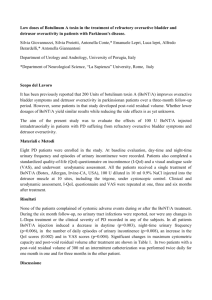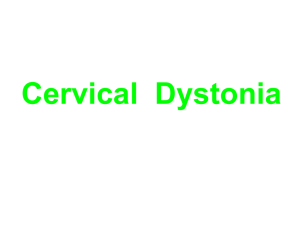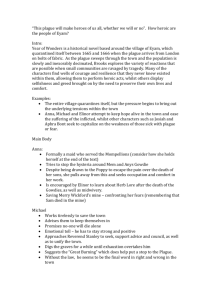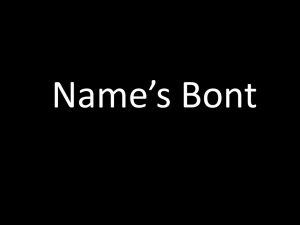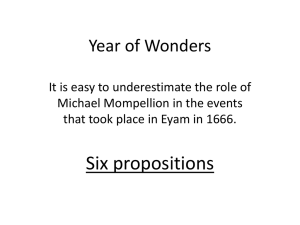Colloidal gold -based immunochromatographic assay for detection
advertisement
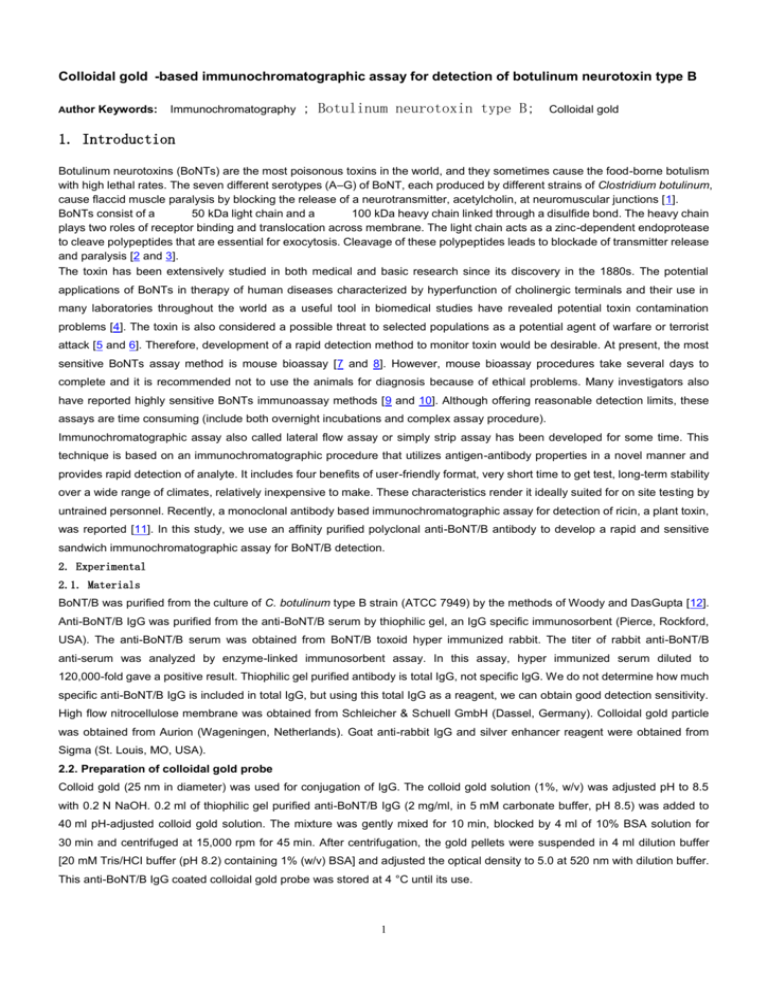
Colloidal gold -based immunochromatographic assay for detection of botulinum neurotoxin type B Author Keywords: Immunochromatography ; Botulinum neurotoxin type B; Colloidal gold 1. Introduction Botulinum neurotoxins (BoNTs) are the most poisonous toxins in the world, and they sometimes cause the food-borne botulism with high lethal rates. The seven different serotypes (A–G) of BoNT, each produced by different strains of Clostridium botulinum, cause flaccid muscle paralysis by blocking the release of a neurotransmitter, acetylcholin, at neuromuscular junctions [1]. BoNTs consist of a 50 kDa light chain and a 100 kDa heavy chain linked through a disulfide bond. The heavy chain plays two roles of receptor binding and translocation across membrane. The light chain acts as a zinc-dependent endoprotease to cleave polypeptides that are essential for exocytosis. Cleavage of these polypeptides leads to blockade of transmitter release and paralysis [2 and 3]. The toxin has been extensively studied in both medical and basic research since its discovery in the 1880s. The potential applications of BoNTs in therapy of human diseases characterized by hyperfunction of cholinergic terminals and their use in many laboratories throughout the world as a useful tool in biomedical studies have revealed potential toxin contamination problems [4]. The toxin is also considered a possible threat to selected populations as a potential agent of warfare or terrorist attack [5 and 6]. Therefore, development of a rapid detection method to monitor toxin would be desirable. At present, the most sensitive BoNTs assay method is mouse bioassay [7 and 8]. However, mouse bioassay procedures take several days to complete and it is recommended not to use the animals for diagnosis because of ethical problems. Many investigators also have reported highly sensitive BoNTs immunoassay methods [9 and 10]. Although offering reasonable detection limits, these assays are time consuming (include both overnight incubations and complex assay procedure). Immunochromatographic assay also called lateral flow assay or simply strip assay has been developed for some time. This technique is based on an immunochromatographic procedure that utilizes antigen-antibody properties in a novel manner and provides rapid detection of analyte. It includes four benefits of user-friendly format, very short time to get test, long-term stability over a wide range of climates, relatively inexpensive to make. These characteristics render it ideally suited for on site testing by untrained personnel. Recently, a monoclonal antibody based immunochromatographic assay for detection of ricin, a plant toxin, was reported [11]. In this study, we use an affinity purified polyclonal anti-BoNT/B antibody to develop a rapid and sensitive sandwich immunochromatographic assay for BoNT/B detection. 2. Experimental 2.1. Materials BoNT/B was purified from the culture of C. botulinum type B strain (ATCC 7949) by the methods of Woody and DasGupta [12]. Anti-BoNT/B IgG was purified from the anti-BoNT/B serum by thiophilic gel, an IgG specific immunosorbent (Pierce, Rockford, USA). The anti-BoNT/B serum was obtained from BoNT/B toxoid hyper immunized rabbit. The titer of rabbit anti-BoNT/B anti-serum was analyzed by enzyme-linked immunosorbent assay. In this assay, hyper immunized serum diluted to 120,000-fold gave a positive result. Thiophilic gel purified antibody is total IgG, not specific IgG. We do not determine how much specific anti-BoNT/B IgG is included in total IgG, but using this total IgG as a reagent, we can obtain good detection sensitivity. High flow nitrocellulose membrane was obtained from Schleicher & Schuell GmbH (Dassel, Germany). Colloidal gold particle was obtained from Aurion (Wageningen, Netherlands). Goat anti-rabbit IgG and silver enhancer reagent were obtained from Sigma (St. Louis, MO, USA). 2.2. Preparation of colloidal gold probe Colloid gold (25 nm in diameter) was used for conjugation of IgG. The colloid gold solution (1%, w/v) was adjusted pH to 8.5 with 0.2 N NaOH. 0.2 ml of thiophilic gel purified anti-BoNT/B IgG (2 mg/ml, in 5 mM carbonate buffer, pH 8.5) was added to 40 ml pH-adjusted colloid gold solution. The mixture was gently mixed for 10 min, blocked by 4 ml of 10% BSA solution for 30 min and centrifuged at 15,000 rpm for 45 min. After centrifugation, the gold pellets were suspended in 4 ml dilution buffer [20 mM Tris/HCI buffer (pH 8.2) containing 1% (w/v) BSA] and adjusted the optical density to 5.0 at 520 nm with dilution buffer. This anti-BoNT/B IgG coated colloidal gold probe was stored at 4 °C until its use. 1 2.3. Preparation of immunochromatographic test strips The composition of the immunochromatographic test device was shown in Fig. 1. The test device was prepared as follows: 2 μl of goat anti-rabbit IgG (0.5 mg/ml) and 2 μl of rabbit anti-BoNT/B IgG (0.325 mg/ml) (in phosphate buffered saline, PBS, pH 7.4) were separately applied near to one end (top) of a cellulose acetate supported strip of high flow nitrocellulose membrane (FF85, capillary rise: 4 cm/70–150 s, W × L: 0.5 mm × 25 mm) and dried for 1 h at room temperature. Nitrocellulose membranes bind antibodies by an electrostatic mechanism. The extremely strong dipole of the nitrate ester interacts with the strong dipole of the peptide bonds of the antibody. The purpose of drying the membrane at room temperature is to fix antibodies to the nitrocellulose. The effects of drying on antibody activity were not assessed but after this step, the antibodies still maintain good activity in following assay experiment. The former antibody was the control antibody and the latter antibody was test antibody. Any remaining active sites on the membrane were blocked by incubation with 1% (w/v) polyvinyl alcohol dissolved in 20 mM Tris/HCl, pH 7.4 (3 ml/strip) for 30 min at room temperature. The strip were washed once with water (3 ml) and dried. In order to assist free mobility of the labeled reagent, the membrane was soaked to sucrose solution (5% w/v, in water) and dried. The anti-BoNT/B IgG coated colloidal gold probe (3 μl/strip) was added to near the other end (bottom) of sucrose-treated strip and dried again. The sucrose, when dried with colloidal gold probe onto a surface, forms a hydrated glaze that is easily and quickly solubilized when aqueous sample introduced. It also protected the colloidal gold probe from irreversibly sticking to the membrane surface after they were dried. 2.3. Preparation of immunochromatographic test strips The composition of the immunochromatographic test device was shown in Fig. 1. The test device was prepared as follows: 2 μl of goat anti-rabbit IgG (0.5 mg/ml) and 2 μl of rabbit anti-BoNT/B IgG (0.325 mg/ml) (in phosphate buffered saline, PBS, pH 7.4) were separately applied near to one end (top) of a cellulose acetate supported strip of high flow nitrocellulose membrane (FF85, capillary rise: 4 cm/70–150 s, W × L: 0.5 mm × 25 mm) and dried for 1 h at room temperature. Nitrocellulose membranes bind antibodies by an electrostatic mechanism. The extremely strong dipole of the nitrate ester interacts with the strong dipole of the peptide bonds of the antibody. The purpose of drying the membrane at room temperature is to fix antibodies to the nitrocellulose. The effects of drying on antibody activity were not assessed but after this step, the antibodies still maintain good activity in following assay experiment. The former antibody was the control antibody and the latter antibody was test antibody. Any remaining active sites on the membrane were blocked by incubation with 1% (w/v) polyvinyl alcohol dissolved in 20 mM Tris/HCl, pH 7.4 (3 ml/strip) for 30 min at room temperature. The strip were washed once with water (3 ml) and dried. In order to assist free mobility of the labeled reagent, the membrane was soaked to sucrose solution (5% w/v, in water) and dried. The anti-BoNT/B IgG coated colloidal gold probe (3 μl/strip) was added to near the other end (bottom) of sucrose-treated strip and dried again. The sucrose, when dried with colloidal gold probe onto a surface, forms a hydrated glaze that is easily and quickly solubilized when aqueous sample introduced. It also protected the colloidal gold probe from irreversibly sticking to the membrane surface after they were dried. Fig. 1. The schematic description of the immunochromatographic test device 2.4. Assay of BoNT/B on test strip and enhancement of the detection sensitivity The assay was carried out by applying a sample (50 μl) of the appropriate test BoNT/B solution to the bottom of the device. The combined solution of test BoNT/B and detection reagent rose up the membrane and colloidal gold was deposited at the site of the solid-phase antibody. In order to detect very low levels of toxin, we used silver enhancement reagent to amplify the signal of colloidal gold. After BoNT/B analysis, the tested strips were washed once with PBS containing 0.1% (w/v) Tween 20 and twice with distilled water. The washed strips then were soaked into a silver enhancer for 5 min and fixed with sodium thiosulfate solution for 3 min at room temperature. 2.5. Cross reactivity of BoNT/B test strip Samples containing 1 μg/ml of BoNT/A or BoNT/E were also assayed by BoNT/B test strip for evaluating cross reactivity. 2.6. Practicability of BoNT/B test strip in simulated sample In order to evaluate the practicability of BoNT/B test strip in real world, we used two different matrices as toxin diluents to mimic actual sample. These samples were prepared by diluting BoNT/B from 1 μg/ml stock solution with the appropriate volume of 2 serum (1:1 in PBS) and urine (1:1 in PBS). The serum was diluted one-fold with PBS because it was too sticky to flow smoothly. The urine was also diluted one-fold with PBS because it was weak acid, which interferes antigen–antibody reaction. Control samples were prepared by directly diluting PBS with various matrices. All samples were assayed by BoNT/B test strip. 3. Results 3.1. Determination of test results A schematic description of the immunochromatographic test device is shown in Fig. 1. In the detection zone, the goat anti-rabbit IgG and rabbit anti-BoNT/B IgG are separately stripped onto control region (C) and test region (T). The Pab coated colloidal gold particles react with goat anti-rabbit antibody and can be trapped in control region, while the BoNT/B bound Pab-coated colloidal gold particles react with anti-BoNT/B antibody and can be trapped in test region. The positive result is judged by the appearance of two red lines in control and test region. The negative result is judged by the appearance of only single line in control region. If no line presents in test strip or only one line in test region, the test is invalid ( Fig. 2). Fig. 2. The illustrations of immunochromatographic test results. See text for details. 3.2. Detection limit of BoNT/B test strip Samples, PBS spiked with various concentrations of BoNT/B, were assayed by BoNT/B test strip. Analysis was complete in less than 10 min, and detection limit was 50 ng/ml of BoNT/B. The red color intensity is proportional to BoNT/B concentration in the range 50–10,000 ng/ml of BoNT/B (Fig. 3). To improve detection limit, the tested strip was treated with silver enhancer. Using silver enhancement, 50 pg/ml of BoNT/B was detected (Fig. 4). In the absence of BoNT/B (PBS only), no immunogold was bound to the solid-phase test antibody. Non-specific binding of the reagents was very low (Fig. 3 and Fig. 4). Control experiments involved the use of colloidal gold particles coated with antibodies to irrelevant proteins (ricin), and no band was revealed in the test region even though 1 μg/ml of BoNT/B was tested (Fig. 3 and Fig. 4). 3.2. Detection limit of BoNT/B test strip Samples, PBS spiked with various concentrations of BoNT/B, were assayed by BoNT/B test strip. Analysis was complete in less than 10 min, and detection limit was 50 ng/ml of BoNT/B. The red color intensity is proportional to BoNT/B concentration in the range 50–10,000 ng/ml of BoNT/B (Fig. 3). To improve detection limit, the tested strip was treated with silver enhancer. Using silver enhancement, 50 pg/ml of BoNT/B was detected (Fig. 4). In the absence of BoNT/B (PBS only), no immunogold was bound to the solid-phase test antibody. Non-specific binding of the reagents was very low (Fig. 3 and Fig. 4). Control experiments involved the use of colloidal gold particles coated with antibodies to irrelevant proteins (ricin), and no band was revealed in the test region even though 1 μg/ml of BoNT/B was tested (Fig. 3 and Fig. 4). Fig. 3. Immunochromatographic detection of BoNT/B. A series of dilutions (10–10,000 ng/ml) of BoNT/B was prepared in PBS. Details on the preparation of the lateral flow test device and assay are described in the text. Non-specific binding is shown in the absence of BoNT/B. The control consisted of colloidal gold coated with antibodies to an irrelevant protein. Fig. 3. Immunochromatographic detection of BoNT/B. A series of dilutions (10–10,000 ng/ml) of BoNT/B was prepared in PBS. Details on the preparation of the lateral flow test device and assay are described in the text. Non-specific binding is shown in the absence of BoNT/B. The control consisted of colloidal gold coated with antibodies to an irrelevant protein. 3.3. Cross reactivity of BoNT/B test strip BoNT/A, BoNT/B and BoNT/E are most frequently associated with human botulinum [1]. The BoNT serotypes exhibit 30–60% sequence identity [13]. Therefore, the cross reactivity of BoNT/B test strip with BoNT/A and BoNT/E were also examined. When 1 μg/ml of BoNT/A or BoNT/E was tested, no band was revealed in the test region (Fig. 5). 3.3. Cross reactivity of BoNT/B test strip BoNT/A, BoNT/B and BoNT/E are most frequently associated with human botulinum [1]. The BoNT serotypes exhibit 30–60% sequence identity [13]. Therefore, the cross reactivity of BoNT/B test strip with BoNT/A and BoNT/E were also examined. When 1 μg/ml of BoNT/A or BoNT/E was tested, no band was revealed in the test region (Fig. 5). 3 Fig. 5. Cross reactivity of BoNT/B test strip. The BoNT/A and BoNT/E test solution were analyzed by BoNT/B test strip. Details on the preparation of the lateral flow test device and assay are described in the text Non-specific binding is shown in the absence of BoNT/B. 3.4. Detection of BoNT/B in various matrices Simulated samples were assayed by BoNT/B test strip. BoNT/B diluted in urine (1:1 in PBS) showed better detection intensity than BoNT/A in serum (1:1 in PBS) (Fig. 6). The detection sensitivity of simulated urine or serum sample was 50 ng/ml, which was the same as BoNT/B in PBS (Fig. 3). Though some components of serum may inhibit the antigen–antibody reaction and result in weak detection band, the BoNT/B test strip is suitable for the detection of these mimic samples. 3.4. Detection of BoNT/B in various matrices Simulated samples were assayed by BoNT/B test strip. BoNT/B diluted in urine (1:1 in PBS) showed better detection intensity than BoNT/A in serum (1:1 in PBS) (Fig. 6). The detection sensitivity of simulated urine or serum sample was 50 ng/ml, which was the same as BoNT/B in PBS (Fig. 3). Though some components of serum may inhibit the antigen–antibody reaction and result in weak detection band, the BoNT/B test strip is suitable for the detection of these mimic samples. Fig. 6. Detection of BoNT/B in various matrices. Simulated samples were assayed by BoNT/B test strip. The labels were serum control (serum 1:1 dilution in PBS), 100 ng/ml of BoNT/B in serum control, 50 ng/ml of BoNT/B in serum control, 10 ng/ml of BoNT/B in serum control, urine control (urine 1:1 dilution in PBS), 100 ng/ml of BoNT/B in urine control, 50 ng/ml of BoNT/B in urine control, and 10 ng/ml of BoNT/B in urine control, respectively. 4. Discussion BoNT/B is an A–B chain structure toxin. In order to develop sensitive and rapid BoNT/B detection methods, we induced several monoclonal anti-BoNT/B antibodies. These anti-BoNT/B monoclonal antibodies were screened for suitability as a strip assay kit, but none of monoclonal antibody pair provided high assay sensitivity. Therefore, we used polyclonal anti-BoNT/B antibody to develop strip assay. The polyclonal anti-BoNT/B antibody was absorbed to colloidal gold particle as a detection antibody and immobilized on the membrane as a test antibody. Using this format, we can obtain the best detection sensitivity. The limit of detection using silver enhancement was 50 pg/ml of pure BoNT/B, close to the sensitivity of mouse bioassay [7]. This enhanced strip assay is sufficiently sensitive to support in vivo BoNT/B distribution analysis and in field BoNT/B contamination detection. The polyclonal-based BoNT/B test strip also show good specificity. There was on cross reaction with BoNT/A and BoNT/E even through 1 μg/ml of toxins were tested. The developed BoNT/B immunochromatographic assay using colored colloidal gold nanoparticles as a tracer provides visual evidence of the presence of BoNT/B in a liquid sample within 10 min. This assay is a semiquantitative test in which results are usually scored on an arbitrary scale, e.g., 0 to ++++. In order to assess the reproducibility of the BoNT/B immunochromatographic assay, BoNT/B was analyzed by intra-assay (assay during one working day) and inter-assay (assay on days 3–7). Both assays can obtain reproducible results semiquantitatively (data not shown). Immunochromatographic assay using blue latex and colloidal gold have been described previously [14 and 15]. In our experience, the use of immunogold detection has three advantages. Firstly, the nanoparticles of colloidal gold have better mobility than blue latex particles in the porous nitrocellulose membrane. Secondly, colloidal gold particles are less susceptible to aggregation during the preparation of the test device. The third advantage is that the enhancement procedure provides the opportunity to improve assay sensitivity. The non-enhanced system and blue latex provide assays with similar detection limit. However, the sensitivity of immunogold detection can be increased approximate 1000-fold with the enhancer described above. This markedly increases the number of analytes that can be detected by this method. Colloidal gold solutions ready for labeling with specific molecules are commercially available. The preparation of individually tailored antigen-specific antibody-gold conjugates will depend on the properties of the individual antibody. Recommended methods for the production of immunogold probes are described in the product data sheets. The BoNT/B strip assay described here exhibits potential as a general assay method for the detection of toxin in biological fluid that requires no separation steps. Moreover, the assay is superior to other immunoassay, such as radioimmunoassay and enzyme-linked immunosorbent assay, with respect to its overall speed and simplicity. These characteristics make strip assay an ideal candidate for development of rapid toxin detection kit. 4 5
